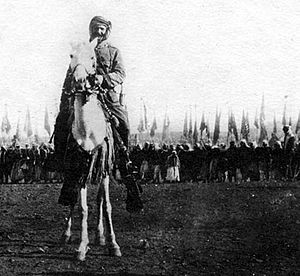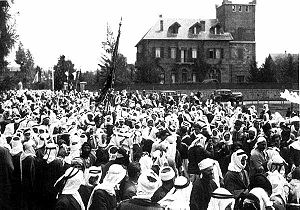- Great Syrian Revolt
-
Great Syrian Revolt 
Sultan Pasha al Atrash, leading his armies against the French Mandate, 1926.Date July 1925 – June 1927 Location French Mandate for Syria and Lebanon Result French victory Belligerents  France
FranceSyrian insurgents Commanders and leaders  Maurice Sarrail
Maurice Sarrail
 Roger Michaud
Roger Michaud
 Maurice Gamelin
Maurice Gamelin
 Henry de Jouvenel
Henry de Jouvenel
 Charles Andréa
Charles AndréaSultan Pasha al-Atrash The Great Syrian Revolt (Arabic: الثورة السورية الكبرى) or Great Druze Revolt (1925-1927) was the largest and longest-lasting anti-colonial insurgency in the inter-war Arab East. Mobilizing peasants, workers, and army veterans, rather than urban elites and nationalist intellectuals, it was the first mass movement against colonial rule in the Middle East. The revolt failed to liberate Syria from French occupation, but it provided a model of popular nationalism and resistance that remains potent in the Middle East today. Each subsequent Arab uprising against foreign rule has repeated the language and tactics of the Great Syrian Revolt.
Contents
Background
After the end of World War I and the defeat of the Ottoman Empire, Syria was put under the French Mandate. The Syrian government formed in the aftermath of the war refused to give up independence and rejected the French mandate. As French forces started to enter the country, they faced revolts in the mountains of Latakia (1919) and in the mountains of Harem in the northwest (1920). These revolts used ambushes and hit-and-run tactics, and were eventually quelled in 1921 after aid stopped coming from Turkey and the Syrian government.
French forces entered Damascus on July 25, 1920 after the Battle of Maysalun. King Faisal fled to Jordan and General Henri Gouraud became High Commissioner. Upon arrival, the French partitioned Syria into five states: Damascus, Aleppo, Alawite State (Latakia), Greater Lebanon, and Jabal el Druze.
Causes
See also: Hauran Druze RebellionAmong the myriad of causes cited by historians for the Syrian Revolt lies the confrontation between the Druze political elite - led by the Atrash clan - and the colonial authorities based in Damascus. The major point of contention between both camps is said to have been the degree of autonomy the French were willing to give the rulers of the Jabal.
Under the guise of "modernization," the French colonial authorities sought to overthrow the traditional/"feudal" political elite and impose their own subordinates as governors of the province. This campaign also sought to impose other aspects of "civilization" upon the Druze Community, such as a secular judicial system - all of which were meant to undercut established norms and practices in the interest of expanding the influence of the colonial authorities.
The straw that broke the camel's back is said to have been Damascus' appointment of Capt. Gabriel Carbillet as governor of Jabal el Druze. According to Michael Provence, author of The Great Syrian Revolt and the Rise of Arab Nationalism, Carbillet "zealously sought to break the grip of Druze 'feudalism' in the region." In implementing his agenda, Carbillet "conscripted the sheikhs for forced labor on modernizing projects such as road-building." Consequent protests by members of the community "were met with repression, villages raised militia, and the regional capital Suwayda was besieged.
Revolution
On August 23, 1925 Sultan Pasha al-Atrash officially declared revolution against France. Calling upon Syria's various ethnic and religious communities to oppose the foreign domination of their land, al-Atrash managed to enlist the aid of large sections of the population in a revolt that now spread throughout Syria, led by such notable figures as Hasan Al-Kharratt, Nasib al-Bakri, Abdul Rahman ash-Shahbandar and Fawzi al-Qawiqji.
Fighting began with the Battle of al-Kafr on July 21, 1925, the Battle of al-Mazra'a on August 2-3, 1925, and the subsequent battles of Salkhad, Almsifarh and Suwayda. After initial rebel victories against the French, France sent thousands of troops to Syria and Lebanon from Morocco and Senegal, equipped with modern weapons, compared to the meagre supplies of the rebels. This dramatically altered the results and allowed the French to regain many cities, although fierce resistance lasted until the spring of 1927. The French sentenced Sultan al-Atrash and other national leaders to death, but al-Atrash escaped with the rebels to Transjordan and was eventually pardoned. In 1937, after the signing of the Franco-Syrian Treaty, he returned to Syria where he was met with a huge public reception.
The results
- Replacement of High commissioners and military officers in Syria. For example High Commissioner Maurice Sarrail was replaced with Henry de Jouvenel[1], after rebels had attacked al-Azm Palace in Damascus.
- Damascus was bombarded severely, and a quarter of the city burned.
- France sent one of the most prominent leaders General Maurice Gamelin after growing strength of the rebels and the victories.
- Reunification of Syria after divided into four small countries: Damascus, Aleppo, and Alawite State, Jabal Druze
- French agreed to the holding of elections won by the opposition, led by Ibrahim Hanano, Hashim al-Atassi
See also
- 2011 Syrian protests
- Army of the Levant
- List of modern conflicts in the Middle East
References
- Al-Hokomat al Souryya fil qarn el eshreen(Syrian governments in the twentieth century: from 1918 to 2000) / Author Su'ad A. Jouma', Hassan Zaza.
- Al-'Alam (Pioneers), c 7, p. 157
Further reading
- Anne-Marie Bianquis et Elizabeth Picard, Damas, miroir brisé d'un orient arabe, édition Autrement, Paris 1993.
- Lenka Bokova, La confrontation franco-syrienne à l'époque du mandat - 1925-1927, éditions l'Harmattan, Paris, 1990
- Général Andréa, La Révolte druze et l'insurrection de Damas, 1925-1926, éditions Payot, 1937
- Le Livre d'or des troupes du Levant : 1918-1936. <Avant-propos du général Huntziger.>, Préfacier Huntziger, Charles Léon Clément, Gal. (S. l.), Imprimerie du Bureau typographique des troupes du Levant , 1937.
French Mandate of Syria topics States Conflicts Franco-Syrian War · Battle of Maysalun · Syrian Revolution · 1936 Syrian general strike · Syria-Lebanon CampaignTreaties Influential
peopleCategories:- 1925 in Syria
- 1926 in Syria
- 1927 in Syria
- French mandate of Syria
- Rebellions in Syria
- Military history of Syria
Wikimedia Foundation. 2010.


